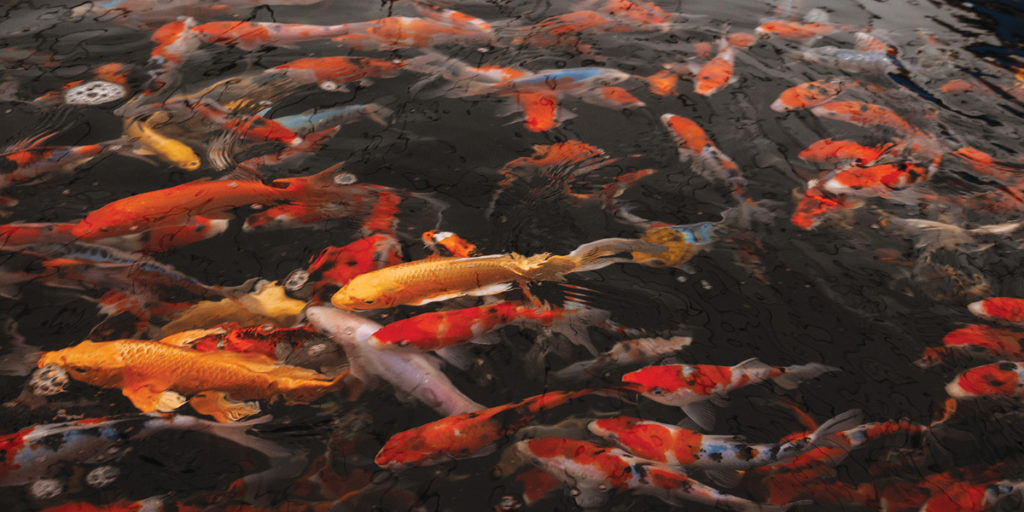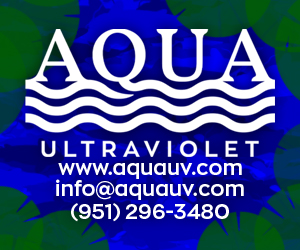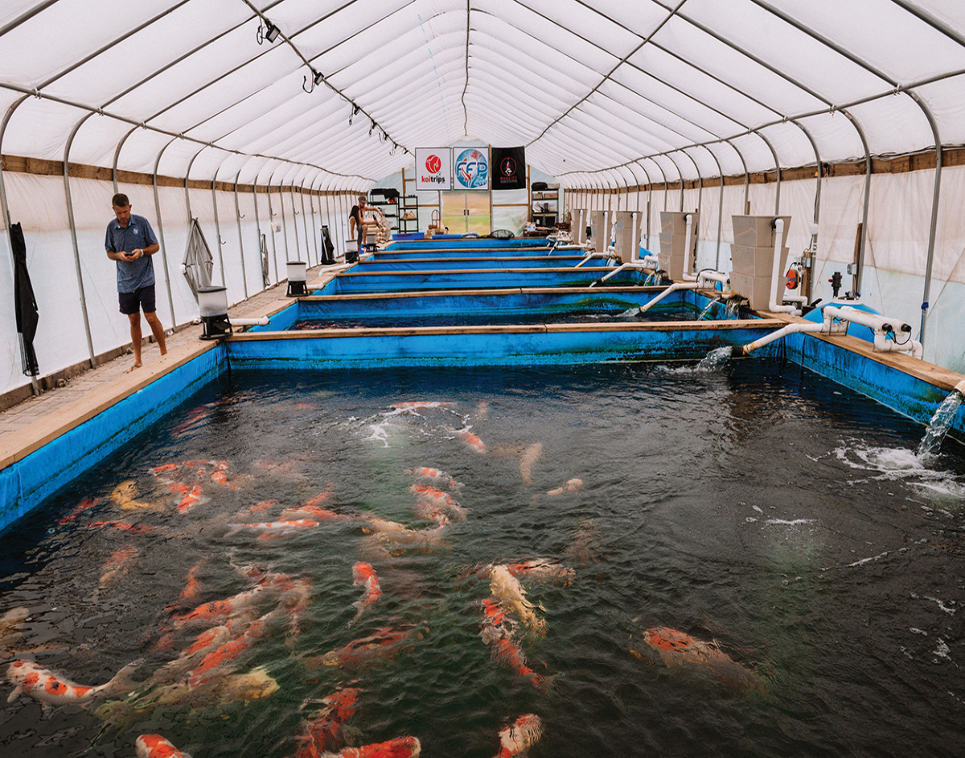
Most pond owners come to have a passion not only for the aesthetic of their pond, but also for the aquatic life that inhabits it. At Fitz’s Fish Ponds, our passion lies with Japanese koi. Over the past decade, we have learned a lot about the optimal ways to keep koi healthy. Everything heavily relies on maintaining an ideal environment for the koi.
Water Quality
Our team, which includes our retail managers and a fish care specialist, believe that pond owners and koi keepers should make the water quality of the pond one of their main focus points when caring for koi.
At the farm, we house thousands of koi in a variety of tanks. We have two 20,000-gallon tanks, six 10,000-gallon tanks, four 4,000-gallon tanks and eighteen 1,500-gallon tanks all inhabited with koi imported from Japan. That’s a lot of water to maintain, which is why we have a water testing system in place.
According to one of our retail managers, Ryan Cardillo, “Water quality should be any pond owner’s top priority. This is why we do water testing so frequently.”
“If the water quality isn’t up to par, and if a fish is sick and needs specific treatment, nothing will work if there are issues with the water,” he continues. “This is the environment the fish are living in, which is why having a good filtration system and a good aeration system is essential to maintaining water quality and keeping fish healthy.”
Filtration Tips
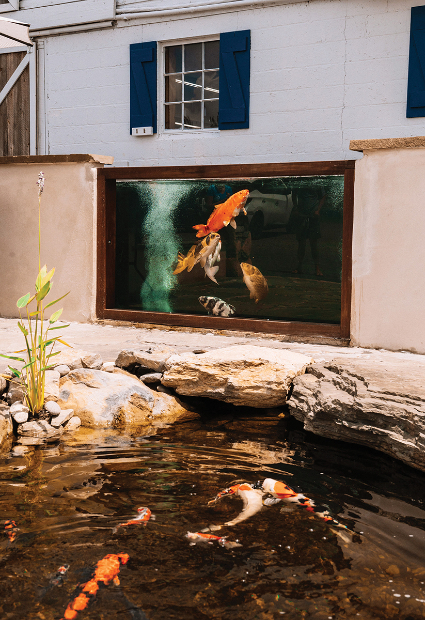
oxygen that is being provided to the koi.
While most pond owners know the importance of filtration, what role does the filtration system play in actually keeping the fish healthy? The filter acts as a collector that cleans the pond while collecting the fish waste. This is why it is essential that the filter be maintained and backwashed on a regular basis, especially if the pond is holding a high stock of fish. The more fish that are held in the pond, the more waste that is produced. If a filter is not backwashed often enough and too much waste is accumulating, this is when koi health issues such as bacterial infections and ulcers — both related to too much anaerobic bacteria in the pond environment — begin to emerge.
So, how often should one back wash their filter? This depends on so many factors that it is difficult to put an exact number on it. Essentially, with a higher fish load, a filter will need to be cleaned more frequently.
In a natural pond that has a river rock or pebble bottom, there are many gaps and holes that can create pockets of stagnant water. Although this can provide a beautiful appearance in the pond, they can act as traps for fish waste. This is why bottom drains are often utilized, as they suck down larger waste and help move this stagnant water.
If too much waste builds up, it can generate a thick muck at the bottom of the pond, trapping pockets of methane and sulfur gas, eliminating oxygen from the water, and causing serious health issues for the fish. When this happens, not only do pond owners notice bacterial infections in their fish, but they also report fish literally gasping for air. These issues can cause a major loss and fish death in the pond. This is why a high-quality aeration system is so important for your aquatic life.
Aeration Nation
Aeration has a number of benefits for the pond and aquatic life that inhabits it. An aerator pumps oxygen through the air stone and creates surface tension while also stirring the water around and keeping the particles moving. This process ensures that any waste in the pond makes its way to the filter and helps to avoid bacterial collection on the bottom of a pond.
Mike Milazzo, also known as “Fish Mike,” is our fish care specialist. He knows just how much koi love the flow of water.
“At the farm, I keep water flowing within the tanks at all times,” he says. “In addition to the aeration systems in the tanks, I make sure there is a constant drip of fresh water going into the tanks.”
Fish Mike recommends that pond owners have multiple aerators in their pond to keep fish at stagnant water. This is why we recommend doing periodic water testing to avoid potential health issues for your fish that could be related to water quality.
Water Testing and Temperature
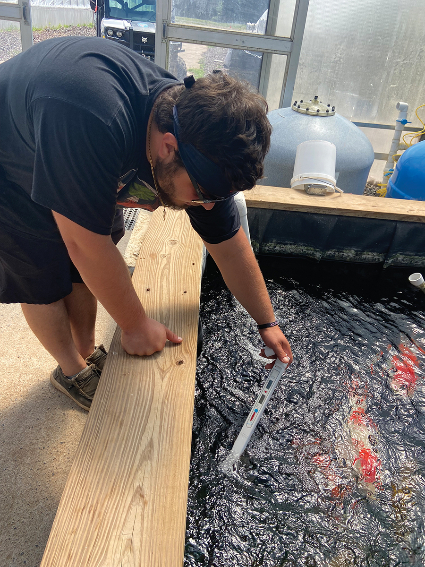
Fish Mike tests the water quality in all the tanks at our farm every other day to keep it in check. We use a kit that tests for ammonia, nitrite, carbonate hardness (KH), salinity, nitrate and pH in the water. The results of the water test may give an indication of what needs to be done or added to the water.
Ideal levels for ammonia and nitrite are 0. If either of those approach 0.50, this is when we start to become alarmed. In order to rectify a problem like this, we would do a larger backwash and add salt. For salinity, we are looking for levels that are between 0.10 and 0.30. In order to measure the salinity, a salt test meter should be used. It is also important to note that if salt levels are too high, it can kill plants in the pond. Low levels of salinity should not impact the plant life too much.
The pH of well water, which is what runs in our tanks throughout the day, is generally around 8, and koi can live in water like this. However, we like to keep our pH range between 7.5 and 7.7. Getting fresh water into the tanks also helps balance out the nitrite levels; therefore, adding fresh water into your pond can also balance nitrite levels if other methods of getting it down are problematic.
“It is extremely important for pond owners to do periodic water testing,” explains retail manager Tom Swinarsky. “There are water-testing kits available for pond owners to purchase and complete at their own leisure. Some pond stores, like ours, will take a sample of the water a customer brings in and test it. Then we are able to provide advice based on the results.”
Pond owners should also be aware of whether their water is city water or well water. If city water is being used to fill a pond, the pond owner can add an in-line detox dechlorinator, which is the popular first option. A second option would be to physically attach a chlorine filter to the hose. Without eliminating the chlorine from the water, fish may begin to die.
The temperature of the water also matters significantly for the koi. The most active time for koi is when the temperature is between 68 – 85 degrees Fahrenheit. Cold water temperatures slow down their digestive system; therefore, when the water reaches below 68, the koi keeper should limit feeding and switch to cold-weather food. This is why having a thermometer for your pond is essential.
Salt Care
Fish Mike has researched the use of salt in fish care and how it can act as a treatment for sick fish. It has made a huge difference in how he approaches caring for a koi that is showing signs of stress in our greenhouse.
“When you notice a fish showing signs of stress — which could include going into a certain part of the pond, showing lack of movement, or perhaps developing an ulcer — one option is raising the salt levels in the tank,” Fish Mike says.
“You can raise the salt level to 0.6 to help the fish heal more quickly than it normally would,” he continues. “Salt assists in the healing of injuries, promotes the formation of slime coating, improves gill function, reduces the uptake of nitrite and decreases osmotic stress.”
It is important to note that raising salt levels should be done only as a temporary treatment. It would not be safe to keep the salt levels this high in the tank at all times. While salt is a huge help and works well for our tank systems, it is not a cure-all. In many cases, other treatments or medications are necessary, depending on the disease. If you have a water garden filled with plants, you may have to set up a separate quarantine tank to treat the fish with salt water.
While it is possible to quarantine a sick fish so that the issues don’t spread to others in the tank or pond, koi don’t like to be isolated. Be sure to re-integrate it into the tank or pond with the others immediately following treatment.
At Fitz’s Fish Ponds, we strive to educate our koi keepers and pond owners to ensure they get to enjoy their pond and fish to the best of their potential. By maintaining and keeping a regular backwashing cycle on the filtration system, ensuring the pond avoids stagnant water with an aeration system, adding fresh water and salt to the pond as needed and doing frequent water checks, pond owners should be able to avoid most health issues with their koi and watch them live long and healthy lives.
